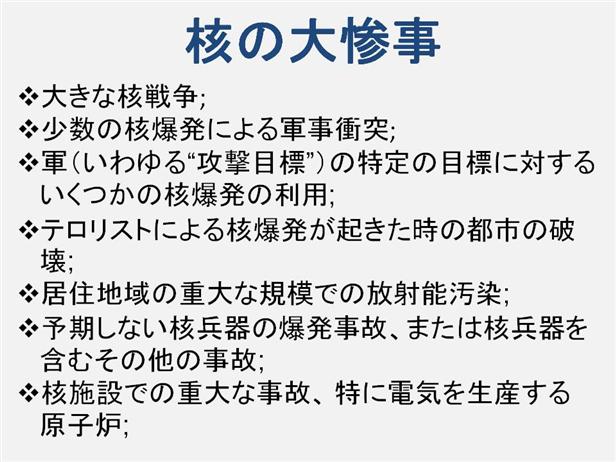| front |1 |2 |3 |4 |5 |6 |7 |8 |9 |10 |11 |12 |13 |14 |15 |16 |17 |18 |19 |20 |21 |22 |23 |24 |25 |26 |27 |28 |29 |30 |31 |32 |33 |34 |35 |36 |37 |38 |39 |40 |41 |42 |43 |44 |45 |46 |47 |48 |49 |50 |51 |52 |53 |54 |review |
 |
v大きな核戦争;
v少数の核爆発で占領する軍事衝突;
v軍(いわゆる“攻撃目標”)は、特定の目標に対するいくつかの核爆発の利用;
vテロリストによる核爆発が起きた時の都市の破壊;
v居住地域の重大な規模での放射能汚染;
v核兵器の予期しない爆発事故、または核兵器を含むその他の事故;
v核施設での重大な事故、 特に電気を生産する原子炉。
Nuclear catastrophes may be of different types. A rough taxonomy lists, in a rough order of decreasing impact: (1) a major nuclear war involving a large number (hundredths, thousands) of nuclear explosions; (2) a military conflict in which few (say, a one-digit number of) nuclear explosions take place, mainly against civilian targets (cities); (3) the military (so-called “surgical”) employment of few nuclear explosions against specific targets, such as deeply-buried bunkers housing key installations, trying to minimize “collateral damage” to civilians; (4) the destruction of a city by a nuclear explosion produced by a terrorist commando; (5) the deliberate radioactive contamination on a significant scale of an inhabited area (so-called “dirty nuclear bomb” or, more properly, “radioactive dispersion device”); (6) the accidental explosion of a nuclear weapon, or other accidents involving nuclear weapons; (7) a serious accident in a civilian nuclear installation, typically in an electricity-producing nuclear reactor. Terse mention of the risk of nuclear-weapon proliferation, a topic that should never be forgotten given its impact on the future of our civilization inasmuch as it largely influences the likelihood that some of the catastrophes listed above shall eventually happen; and with the opposite prospect of progress towards the achievement of a nuclear-weapon free world. |